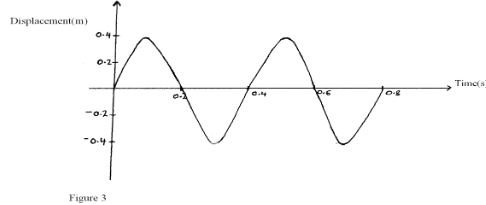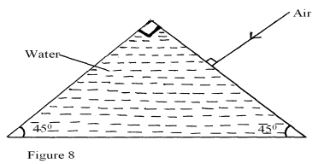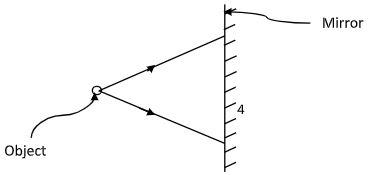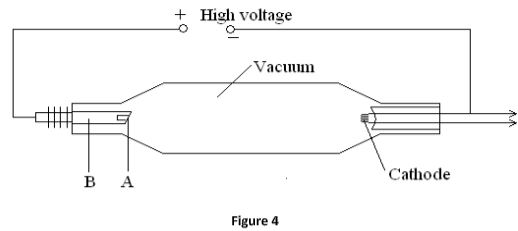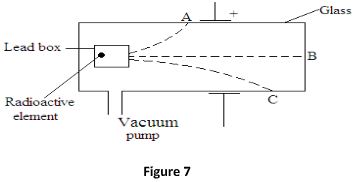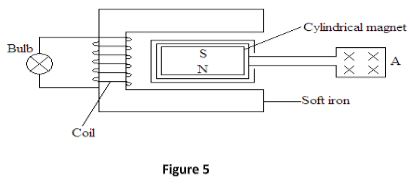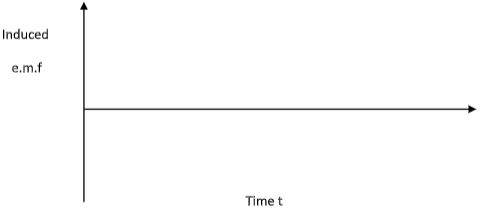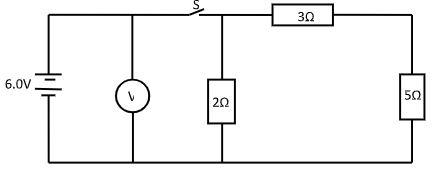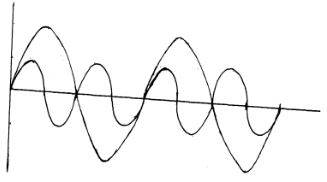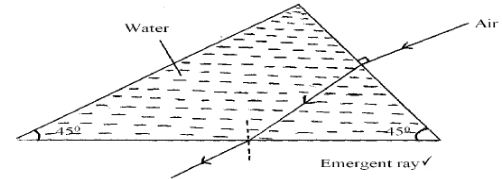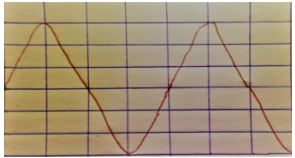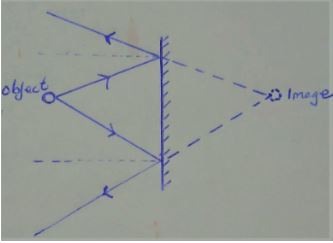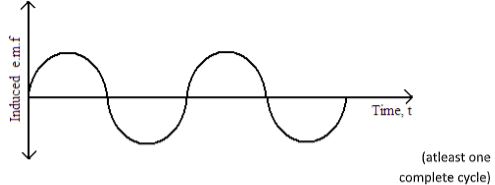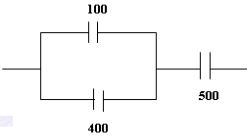Questions
INSTRUCTIONS TO THE CANDIDATES:
- This paper consists of two sections: A and B.
- Answer all questions in section A and B in the spaces provided.
- All working must be clearly shown in the spaces provided in this booklet.
- Scientific calculators and KNEC mathematical tables may be used except where stated otherwise.
Section A ( 25 marks)
Answer ALL the questions in this section.
- State one use of magnets. (1mk)
- Two mirrors are incline at 600 to each other. Determine the number of images observed and state one application of this arrangement. (3mks)
- Explain the purpose of manganese (IV) oxide in a dry cell. (1mk)
- The period of a wave is T seconds. Its wavelength is λ metres. Show that V= fλ where v is the speed of the wave and f is the frequency. (2mks)State one
-
- application of force on a current carrying conductor placed in magnetic field. (1mk)
- Your house is supplied with 240 v from a power source which is fitted with a 13 A safe fuse. What is the maximum number of 60w bulbs that can be fitted in the house? (2mks)
- What causes electrical resistance in conductors? (1mk)
- Figure 3 shows how the displacement of a point varies with time as waves passes it.
On the same diagram, draw a wave which passes the point with twice the frequency and half the amplitude of the one shown. (2 marks) - Figure 8 shows a ray of light incident on the face of a water prism.
Sketch the path of the ray as it passes through the prism. Critical angle for the water is 490. (2mks) - A boy observes his face in a concave mirror of focal length 100cm. If the mirror is 80cm away, state one characteristics of the image observed (1mks)
- Describe how microwaves are used in determining distances of objects as in the radar.(3mks)
- An alternating voltage of peak value 15v and frequency 25Hz is applied to the terminals of a Cathode ray oscilloscope. The Y-gain is set at 5 v/cm and the time base at 10 ms/cm. Draw the trace observed on the screen. (2mks)
-
- Name all the radiations of the electromagnetic spectrum which have higher wavelengths than the visible light. (1 mark)
- State the radiation that is detected using a blackened bulb of a thermometer. (1 mark)
- The figure below shows two rays drawn from an object on to the mirror.
Complete the ray diagram to show the position of the image. (2 marks)
SECTION B (55 MKS)
-
- Figure 4 below shows an X – ray tube
- Label the parts A and B. (2mks)
- Suggest with a reason the material used for A. (2mks)
- State the reason why the X –ray tube is evacuated. (1mk)
- For the X – ray tube how would the following be controlled;
- The intensity (1mk)
- Quality of X- rays (1mk)
- The exposure to patients (1mk)
-
- A potential difference of 50KV is applied across an X-ray tube. Given that the charge of an electron e = 1.6 x 10-19coulombs and the mass of an electron Calculate the kinetic energy of the electrons. (3mks)
- If 12% of the electron energy is converted into X-ray, determine the minimum wavelength of the emitted X –ray given planks constant h = 6.63 x 10-34 (3mks)
- Figure 4 below shows an X – ray tube
-
- Figure 7 below shows the deflection from a radioactive isotope by an electric field.
- Define the term isotope. (1mk)
- Identify the radiations A,B, and C (3mks)
- Give one use of a radioactive isotope in medicine. (1mks)
- Radium 22688Radisintegrates into a new stable element lead 20682Pb how many alpha and Beta particles are emitted (3mks)
- A 32g sample of radioactive substance was reduced to 2g in 96 days. What is the half life of the substance. (2mks)
- Figure 7 below shows the deflection from a radioactive isotope by an electric field.
-
- Distinguish between self-induction and mutual induction. (2mks)
- In what form is energy lost in acable during transmission. (1mk)
- State the difference between a step-up transformer and an induction coil. (1mk)
- Figure 5 below shows a diagram of a bicycle dynamo. The wheel A is connected by an axle to a permanent cylindrical magnet and is rotated by the bicycle tyre.
- Explain why the bulb lights. (2mks)
- If you were riding the bicycle, what would you do to make the bulb light more brightly? (2mks)
- On the axes provided, sketch the graph of induced e.m.f with time(1mk)
-
-
- A 10 μf capacitor is charged to a potential difference of 300V and isolated. It is then connected in parallel to a 5 μF capacitor. Find the resultant potential difference. (3mks)
- The energy stored before connection. (3mks)
- The energy in the two capacitors after connection. (3mks)
-
- State how distance of separation between the plates affect the capacitance of a parallel plate capacitor. (1mks)
- Three capacitors of capacitance 100µƒ, 500aF and 400µƒ are connected together in a circuit.
Draw a circuit diagram to show the arrangement of the capacitors which gives an effective capacitance of 250µƒ (1mks)
-
-
- Differentiate between an Ohmic and non-ohmic conductor giving one example in each case.(2marks)
- Figure 7 shows a circuit with resistors and voltmeter connected to a battery.
- If each cell has an internal resistance of 0.7Ω, determine the total resistance in the circuit.(3mks)
- What amount of current flows through the 3Ω resistor when the switch is closed? (3mks)
- What is the reading of the voltmeter when the switch S is
- Open (1mk)
- Closed (1mk)
- Account for the difference between the answers in (I) and (II) above. (1mk)
Marking Scheme
- Magnets are used -
- In hospitals to extract iron particles from eyes
- Making loudspeakers, dynamos e.t.c.
( any one correct) ✓ 1
-
- n = 360 - 1 ✓ 1
60
= 6 – 1
= 5 images ✓ 1 - Used by designers to obtain ideals ✓ 1
- n = 360 - 1 ✓ 1
- Manganese oxide converts the hydrogen gas produced to water.✓ 1
- Distance = λ cm
Time = T (s)
Speed = distance = λ
Time
⇒ V = λ
T ✓ 1
But I = f
T
∴ v = fλ ✓ 1 -
- Used in meters, moving coil loudspeakers. (any one )✓ 1
- P=VI
60n = 240×13
n = 52bulbs
- Electrical resistance is caused when a charge flowing through a conductor is slowed by collisions with atoms and impurities in the conductor.✓ 1
-
Amplitude ✔
1 Cycle
Frequency ✔ -
- Image is virtual/ erect/magnified
- A narrow beam of microwaves is sent out in the short pulses from the radar. Distant objects in the path of the beam reflect part of the waves back. The reflected waves give the direction and the distance of the reflecting object.
-
Peak voltage
Correct period -
- radio waves, microwaves and infra red
- infra red
-
-
-
- A – target;
B – Anode; - A Tungsten /molybdenum
High melting point; - To reduce energy the electrons would lose in ionizing the atoms of air molecules;
-
- Varying the heater current;
- Varying the accelerating potential;
- Using the lead shield
- A – target;
-
- Kinetic energy = Electrical energy
= eV ;
= 1.6 x10-19 x5 x 104;
= 8 x 10-15 J ; - λmin = hc/eV
= 6.63 x 10³⁴ x 3 x 10⁸
0.12 x 8 x 10-15
= 2.07 x 10-10m
- Kinetic energy = Electrical energy
-
-
-
- Element having the same atomic number but different mass number;
- A Beta particles;
B ; ϒ - rays
C Alpha particles
- Radio active iodine – 131 used in diagnosis and treatment of goitre (thyroid disorder)
Cobalt – 60 used in treatment of cancer
Sterilization of medical equipment with (any one correct) - 22688Ra → 20682Pb + x(42He) + y (0-1)
4x=20
2x-y=6
Alpha particles = 5 beta particles =4 - 32g → 16g → 8g → 4g → 2g
96 days = 4 half lifes
1 half life = 96/4 = 24 days
-
-
- Self induction is where a changing magnetic field round a conductor induces current/ e.m.f in the same conductor;
Mutual induction – where a changing magnetic field in one coil or circuit induces an e.m.f /current in another circuit or near it - Heat energy;
- Step up transformer uses A.C only while induction coil uses D.C;
-
- when magnet is rotated by the axle, there is change in magnetic flux. This change links the flux to the coil and induces e.m.f; The induced,/ generated current flows in the circuit and makes the bulb to light;
- Cycling faster; makes the rate of change of flux increase as the wheel rotates the axle and the magnet; This increases the magnitude of induced e.m.f and makes the bulb brighter
-
- Self induction is where a changing magnetic field round a conductor induces current/ e.m.f in the same conductor;
-
-
- Q = CV
Q = 10 x 10-6 x 300
= 3.0 x 10-3 C
CT= 5 + 10 = 15 μ f.
V = Q/ C
= 3.0 x 10-3 ✓ 1
15 x 10-6
= 200volts ✓ 1 - E = ½ CV2 ✓ 1
= ½ x 10x 10-6 x 300 x 300 ✓ 1
= 0.45J ✓ 1 - E = ½ x 15 x 10-6 x 200 x 200 ✓ 1
= 0.3J ✓ 1
- Q = CV
-
- Increasing the separation distance capacitance reduces while decreasing separation distance the capacitance increases.
-
-
-
- Ohmic conductor obeys Ohm’s law/ forms straight line through the origin on V-I graph e.g copper, aluminium while non-ohmic conductor doesn’t obey Ohm’s law and the graph of V-I is not a straight line through the origin e.g semi-conductor, thermistor, bulb.
-
- Rseries = 3Ω +5Ω = 8Ω Rparallel = 8 x 2 = 16/10 = 1.6 Ω
8+2
total resistance = 1.6 + 0.7 x 2 = 3.0 Ω - Total current It = V/Rt = 6/3 = 2A
Vparallel = 1.6 x 2 = 3.2 V
I3Ω = 3.2/8 = 0.4 A -
- 6.0 V
- 6.0 – 3.2 = 2.8 V
-
- Lost voltage- is the energy used to drive electrons through the cell itself.
- voltage required to overcome the internal resistance of the cell
- Rseries = 3Ω +5Ω = 8Ω Rparallel = 8 x 2 = 16/10 = 1.6 Ω
Download Physics Paper 2 Questions and Answers - ACK Diocese Mumias Joint Evaluation Mock 2022.
Tap Here to Download for 50/-
Get on WhatsApp for 50/-
Why download?
- ✔ To read offline at any time.
- ✔ To Print at your convenience
- ✔ Share Easily with Friends / Students

